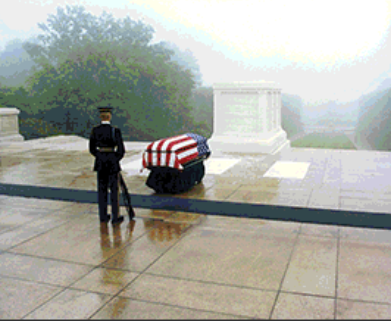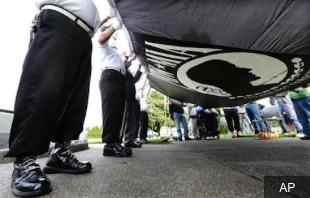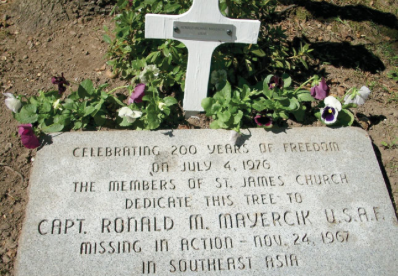
[SatNews] More than 83,000 Americans are missing from World War II, the Korean War, the Cold War, the Vietnam War and the 1991 Gulf War.
The following information contains a statement from the Department of Defense.
National POW/MIA Recognition Day is Friday, September 19, 2014. Each year the president issues a proclamation asking Americans to observe the day as a remembrance of the nation's service members who were held prisoner or are still missing, and their families who live with unanswered questions every day.
The day's events include a Pentagon commemoration ceremony hosting former prisoners of war, family members, military service members and distinguished guests. Traditionally held on the third Friday in September, the event includes formal military honors and remarks from a keynote speaker.

"Keeping the Promise", "Fulfill their Trust" and "No one left behind" are several of many mottos that refer to the efforts of the Department of Defense to recover those who became missing while serving our nation. More than 83,000 Americans are missing from World War II, the Korean War, the Cold War, the Vietnam War and the 1991 Gulf War. Hundreds of Defense Department men and women — both military and civilian — work in organizations around the world as part of DoD's personnel recovery and personnel accounting communities. They are all dedicated to the single mission of finding and bringing our missing personnel home. The mission requires expertise in archival research, intelligence collection and analysis, field investigations and recoveries, and scientific analysis.
"Keeping the Promise", "Fulfill their Trust" and "No one left behind" are several of many mottos that refer to the efforts of the Department of Defense to recover those who became missing while serving our nation. More than 83,000 Americans are missing from World War II, the Korean War, the Cold War, the Vietnam War and the 1991 Gulf War. Hundreds of Defense Department men and women both military and civilian work in organizations around the world as part of DoD's personnel recovery and personnel accounting communities. They are all dedicated to the single mission of finding and bringing our missing personnel home. The mission requires expertise in archival research, intelligence collection and analysis, field investigations and recoveries, and scientific analysis.
Observances of National POW/MIA Recognition Day are held across the country on military installations, at state capitols, in local communities, schools and at various veterans' facilities. Many events observe the tradition of a "Missing Man Table," which is a set dinner table that remains empty in honor of the more than 83,000 missing service members from past conflicts.
As a result of resolutions passed in Congress, the first official commemoration of POW/MIAs was in 1979, when the first national ceremony was held. The observance is one of six days of the year that Congress has mandated the flying of the POW/MIA flag, created by the National League of Families, at major military installations, national cemeteries, all post offices, VA medical facilities, the World War II Memorial, Korean War Veterans Memorial, the Vietnam Veterans Memorial, the offices of the secretaries of state, defense and veterans affairs, the director of the selective service system and the White House.
The Department of Defense has more than 600 people dedicated to the worldwide mission of accounting for the more than 83,000 missing service members from conflicts as far back as World War II.
Starting in 2012, recently accounted for service members will be listed in the chronological order that they are accounted for, which means that the families have been notified. In previous years, they were listed by the date of identification. The highlighted names are linked to a more detailed news release on that serviceman's identification. A complete listing of recently accounted for service member can be found here. A complete listing of recently account-for servicemembers can be found here.
This ends the report from the DoD.
In Today's news, September 19, 2014 there is an article:
Pentagon ‘Seeking Answers’ On POW/MIA Day While Withholding Answers On Korean War POWs
Here's an excerpt:
On Friday, this year’s POW/MIA Day, the Defense POW/Missing Personnel Office issued a new fact sheet on its efforts to recover US POW/MIAs from North Korea and the Korean War. But there may be some roadblocks on the way, according to a report from KPOW.
“Finding live Americans is the highest priority of our accounting process,” the fact sheet said.
“DPMO, with the full support of the U.S. intelligence community, aggressively investigates all credible reports and sightings of alleged American survivors of the Korean War living in North Korea. Since 1995, more than 25,000 defectors from North Korea have been screened for information concerning Americans possibly living in the North.”
POW research specialist Mark Sauter sent a Freedom of Information Act (FOIA) request to the Department of Defense concerning missing U.S. personnel captured during the Korean War that continued to live in the DPRK, PRC and Soviet Union Bloc countries. When the DoD responded, they provided little information. Alesia Williams, chief of the Freedom of Information Act Staff, provided the following information.
- Upon review, I have determined that some portions of two documents (9 pages) must be withheld in part from disclosure pursuant to the FOIA…
- Further, I have determined that the remaining five responsive documents (33 pages) must be withheld in full pursuant to the FOIA. These withheld documents are exempt from release pursuant to Exemptions 1, 3, and 6 of the FOIA…
- Exemption 6 applies to information which if released would constitute an unwarranted invasion of the personal privacy of other individuals.
But with documents being kept secret, including the ones above, it will be difficult for the DPMO move forward with its mission to find these people–especially since they implied their efforts have failed thus far.
“To date, this effort has produced no useful information concerning live Americans,” the release said. The DPMO failed to mention that it and other government agencies are keeping the secrets that may answer some questions as to what happened to U.S. servicemen held in North Korea, China, and the Soviet Union after the Korean War, and other Americans reportedly imprisoned in North Korea during the Vietnam War and possibly the Cold War. KPOW reports:
The latest example is the refusal of the Defense Intelligence Agency (DIA) to release five documents on US POWs from the Korean War seen alive after in North Korea, China and/or the former Soviet Union. You can see the letter DIA sent us [here], which asserts the documents are still classified and also cannot be released for other reasons.
The documents DIA did release to KPOWs under this request seem like “useful information” to us, contrary to DPMO’s claims that no such evidence has surfaced.
Reports 'still secret' which can be found here.
SatNews.com's Additional Information
POW-MIA panel probes satellite photos for evidence of messages from GIs
October 08, 1992| By Barbara Crossette | Barbara Crossette, New York Times News Service
WASHINGTON A Senate committee investigating the fate of Americans still unaccounted for from the Vietnam War has turned its attention to reports that satellite photography may have picked up messages from prisoners as late as 1988.
The panel, the Senate Select Committee on POW-MIA Affairs, plans to hold hearings on this issue October 15 and 16 but has not decided how much will be open to the public, Sen. John F. Kerry, D-Massachusetts, the committee chairman, said yesterday.
The committee has been holding closed intelligence briefings on the issue, and many once-classified government documents have been made public.
The photographs under investigation, analyzed in newly released Pentagon and CIA documents, seemed to show letters or symbols marked on the ground or incorporated in building markings. The signs appear to match those that service personnel were told to use to identify their locations in captivity.
Some analysts accept that the symbols may be a military code, but say they have no evidence that Americans created them. Vietnam has insisted since 1973 that all U.S. prisoners of war, including those in Laos, were returned that year.
The two most compelling cases of apparent messages involve markings spotted on the roof of the Dong Mang prison camp, near Cam Pha in northern Vietnam, in May 1976, and the letters "USA" and possibly "K" an assigned code seen on a rice field near Sam Neua, Laos, in 1988.
In the field in Laos, a photograph in January 1988 picked up "USA" in 11-foot-tall letters over an area where it had not been the previous autumn and would not be the following spring. The "K" seemed an older marking.
Missing Americans were known to have disappeared in the area. But U.S.-backed anti-government Laotians also operated there, and U.S. officials in Southeast Asia suspect the letters could have been dug into The ground by the rebels, some of whom have close ties with Americans who have been active in the POW-MIA issue.

Letters to the Editor/The Star-Ledger on March 28, 2012
The United States has suspended the search for the remains of American servicemen in North Korea because that country launched a satellite (U.S. ceases efforts to recover remains of troops in N. Korea, March 22). That must be comforting to the families hoping for some closure.
Joe Baeli, Saddle Brook
POW/MIA Activist Organizations
The National League of Families' POW/MIA flag, created in 1971 when the war was still in progress.
The National League of Families of American Prisoners and Missing in Southeast Asia was created by Sybil Stockdale, Evelyn Grubb and Mary Crowe as an originally small group of POW/MIA wives in Coronado, California and Hampton Roads Virginia in 1967. Sybil Stockdale's husband, Navy Commander James Stockdale, was shot down in 1965 and she was determined to make the American people aware of the mistreatment of U.S. POWs. This publicity resulted in better treatment of U.S. POWs from fall 1969 on.
After the war, the National League of Families became the leading group requesting information about those still listed as missing in action. It was led by Ann Mills Griffiths. Its stated mission was and is "to obtain the release of all prisoners, the fullest possible accounting for the missing and repatriation of all recoverable remains of those who died serving our nation during the Vietnam War in Southeast Asia." The League's most prominent symbol is its POW/MIA flag. This group was more established, less radical, and more connected to the government.
The National Alliance of Families For the Return of America's Missing Servicemen was founded in 1990. Its goal was and is to resolve the fates of any unreturned U.S. prisoners of war or missing in action from World War II on forward, not just Southeast Asia, and to gain the return of any live prisoners. It is a 1980s-origined splinter from the National League of Families, created by members who were dissatisfied with Ann Mills Griffiths' leadership. Compared to the older group, the National Alliance took a more activist, radical stance, especially towards belief in the existence of live prisoners in Southeast Asia.
The chair and co-founder of the group is Dolores Apodata Alfond, whose brother was shot down in 1967 during the Vietnam War.
The group was visible during the Kerry Committee hearings of the early 1990s, but disagreed with the committee's findings that there was no compelling evidence of any live prisoners in Southeast Asia.
Mr. Perot told the committee counsel that on several occasions between 1969 and 1987 he had discussed possible trades of money or equipment for prisoners.
Recovery and "rescue" — In the mid-1980s, the U.S. and Vietnam increased the frequency of high-level policy and technical meetings to help resolve the POW/MIA issue. The U.S. government viewed this work as a humanitarian obligation. The Vietnamese slowly began to return American remains that they had previously collected and stored; eventually they permitted the U.S. to excavate a few crash sites. The Lao government, with whom the USG maintained diplomatic relations, also agreed to several crash-site excavations in the mid-1980s. This resulted in the return and identification of the remains of a few dozen Americans. In Cambodia, political turmoil prevented such efforts.
Families with a light on wait decades for someone, not knowing...Perhaps it is this aspect of war that is the most difficult to comprehend...
POW/MIA Event This Hometown Doesn't Forget Its Hero
By Jessica Damico, Staff Writer

Gone but not forgotten...a neighborhood holds on to the memory of a missing soldier.
A marker in the Memorial Garden at Edison's St. James Episcopal Church honors MIA U.S. Air Force Capt. Ronald M. Mayercik. His parents' ashes are buried beside it. Serving the country came naturally for U.S. Air Force Capt. Ronald Mayercik. He had cemented the plans at the tender age of 10, according to his sister, Jan Buttler.
"Ron always knew he wanted to fly, and he always knew he wanted to serve in the military," she said. "But no one ever expected this to happen."
Ron, who enlisted after graduating Edison High School in 1962, went missing in action (MIA) on Thanksgiving Day of 1967. He was serving as a navigator when his F-4 fighter plane crashed in Southeast Asia during the Vietnam War. He was 23 years old. Buttler, a resident of Lake Como, remembers receiving a visit from two Air Force men who came to break the news.
"The Air Force assured my parents that he'd be coming back," she said, adding that the family took comfort in the thought that he was still alive.
Gone but not forgotten...a neighborhood holds on to the memory of a missing soldier.
Ron's family was left in limbo, sending care packages that the Red Cross would attempt to deliver to prisoners of war (POWs) and then feeling devastated when the packages were returned. Betty and Michael Mayercik, Ron's parents, traveled to Vietnam in hopes of finding their son, to no avail.
Annual meetings with government officials and other members of the National League of POW/MIA Families also proved fruitless year after year, save for connections made with others who felt their pain.
"We formed really tight bonds," Buttler said.
Renewed hope came in 1973, when more than 500 POW troops were returned to America through Operation Homecoming. When Ron was not among them, his family stopped thinking of him as a POW and came to the hard realization that he was MIA, Buttler said.
It wasn't until 2000 when the family received news about their loved one. Ron's dog tags were found in North Vietnam, despite Air Force officials having told the Mayerciks that Ron went missing in Laos, Buttler said.
"They said they did find credible evidence that a plane did go down there," she said, adding that her family has heard nothing more of Ron since then. Michael and Betty Mayercik both died in 1993. "My mother's last words before she went into the coma were, "Maybe now we'll find out about your brother," Buttler said. Both parents were cremated, and their ashes were buried next to a plaque commemorating Ron in the Memorial Garden at St. James Episcopal Church, 2136 Woodbridge Ave.
And on September 21, as she does each year, Buttler will gather with others from the community for a POW-MIA ceremony at St. James. Hands of Hope, the food pantry at the church, hosts the event.
"It's an opportunity for the family to reconnect and to know he's not forgotten," Hands of Hope President Jackie Goedesky said, adding that Ron remains listed as a member of St. James. Along with Buttler, Ron's nieces and nephews and others from the community, including many of his old friends from high school, turn out for the ceremony, according to Goedesky. "Last year after the ceremony, as I looked around I thought, 'This is like a homecoming'," she said. Joining Goedesky in organizing the event are Middlesex County Freeholder Charles Tomaro, retired U.S. Army Master Sgt. Ray Muniz, who will emcee the event, and Hands of Hope members Patty Colletto, Jennifer Turbitt and Sal Infusino.
The ceremony, starting at 1 p.m., typically begins with the arrival of the nonprofit motorcycle group, Rolling Thunder, which is dedicated to locating POW/MIA troops. Performances will follow by the Middlesex County Police and Fire Pipes and Drums, as well as the Edison High School choir. A chaplain from Joint Base McGuire- Dix-Lakehurst will offer prayers, and the Sayreville American Legion Post 211 will present the colors and conduct a rifle salute. Girl Scout Troop 80573 of Edison will recite the Pledge of Allegiance. Bruce Walker, a member of Bugles Across America, will play 'Taps.'
A 'Missing Man Table Ceremony' will also be conducted, with a table set for a dinner to honor the missing soldiers. "It's very moving," Goedesky said.
Edison Mayor Antonia Ricigliano, freeholders Patrick Diegnan and Tomaro, and other dignitaries are slated to speak, as is Tom Engkilterra, regional coordinator for the National League of POW/MIA Families. Buttler will speak about remembering her brother. She said the annual ceremony is a day to which she looks forward. "It also helps because when you look at it, my brother loved his country, and the fact was, he was a patriot," she said. "So the fact that many other countrymen remember and honor my brother, it's a tribute."

